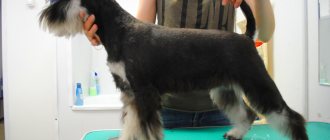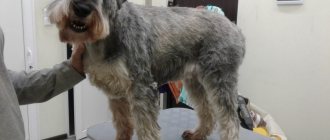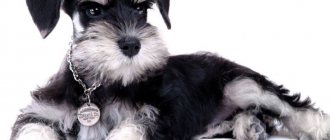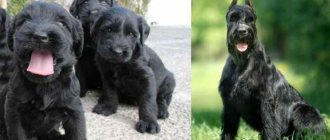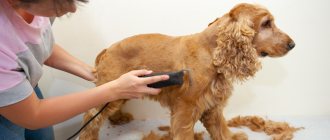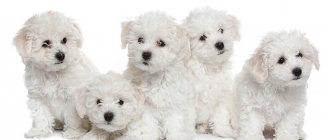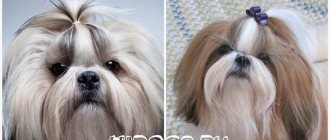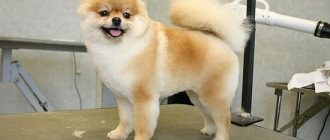The Miniature Schnauzer is an original and charismatic breed of dog. It is distinguished by a luxurious exterior. He boasts long bangs and an impressive beard, and his thick, wiry coat is a delight to look at.
The impeccable beauty of the Miniature Schnauzer is not a gift from nature, but the result of the long and painstaking work of the groomer. Be sure to study the basic rules for caring for a small representative of this breed and remember the golden truth that a dog is a mirror image of its owner.
What types are there
According to its purpose, grooming of this breed is divided into several types.
Cosmetic (hygienic)
Must be done once a month. It includes: combing the undercoat, trimming the hair on and around the paw pads, removing hair in the ears, trimming the hair on the ears, trimming the beard and bangs, removing excess hair in the groin area and under the tail.
Base
Carry out once every 2-3 months. Its procedure includes trimming dead fur (undercoat) and trimming it along the body, as well as all the listed hygiene measures.
Seasonal
Particularly important during the period of active molting of the animal (2 times a year). Between seasonal grooming, hygienic and basic grooming are required.
Exhibition
Necessary for preparing the dog for the ring and show events.
Incorrectly carried out grooming can ruin the dog’s appearance and cause the Miniature Schnauzer to be deprived of promising exhibitions. Trust your pet in the hands of a professional groomer who knows the characteristics of the breed.
Features of the coat
The official breed standard states that the Miniature Schnauzer's body is covered with two-layer hair. A thick undercoat is hidden under the not too short awn. True, it does not indicate that dog spines are divided into 3 types:
- young (shortest);
- ripe (medium);
- old (longest, hardest and dullest).
Dead hair does not perform any important functions other than protecting the dog from pollution. The old coat worsens the dog's appearance and begins to fall out over time. As a result, without appropriate grooming, the dog looks unkempt and does not receive high marks at shows.
On a note. The Miniature Schnauzer's hair grows in layers. But only part of the fur falls out on its own. The rest is carefully removed, trying not to touch the bottom layer.
Haircut scheme
Sketchy cutting and trimming a Miniature Schnauzer is not an easy task, especially when it comes to preparing it for an exhibition.
Mature hair is trimmed along the body, starting from the neck, smoothly moving along the back and sides towards the tail. The hind legs are usually trimmed to the hocks.
The following areas can be cut with a clipper: the inside of the neck, the area under the tail and the ears.
Scissors are used to trim the muzzle and bangs, front and hind limbs and the lower line of the body.
An easier way is to cut it with a clipper, without any special frills. In this case, the neck and back are cut short, the hair on the paws is trimmed with scissors, and a so-called skirt is left on the stomach. The beard and bangs, in this case, emphasize the breed.
Muzzle trim
The Miniature Schnauzer's muzzle is his calling card. She is adorned with a massive beard and elegant bangs. The muzzle must be properly designed and always well-groomed. Considering the fact that a beard constantly gets dirty, caring for it is especially important.
The length of the beard can vary, but should not be short. The hair on the muzzle is combed down from the extreme corner of the eye, and on the bridge of the nose, parted in the middle.
Next, the beard is trimmed with scissors and, if necessary, thinned. Closer to the nose, the beard is slightly shorter than in the cheekbone area. The bridge of the nose is not trimmed.
The bangs are a decoration for the Small Schnauzer. It falls over the eyes, but does not cover them completely. The bangs can be short or long, straight or oblique, or in a trapezoid shape. In any case, its presence is mandatory. When forming bangs, long hair from the forehead is combed down to the eyes (1.5-2 cm wide) and then trimmed.
The absence of bangs and beard is not stipulated by the breed standard.
Dog grooming
In addition to trimming, the Miniature Schnauzer needs basic hygiene procedures. Caring for your dog comes down to periodic bathing and regular brushing:
- Before combing, the coarse coat of the miniature is moistened with conditioner and only then treated with a slicker or metal comb.
- Bathe your Miniature Schnauzer as it gets dirty. Bath procedures are carried out in a warm room using shampoo for wire-haired dogs.
Grooming and trimming a miniature schnauzer is not a tribute to fashion, but a necessity that helps maintain the health and aesthetic appearance of the animal. A plucked and trimmed dog will become the real pride of the owner and will receive high marks from experts. In Moscow and other large cities there are many salons staffed by skilled grooming specialists. But it is much more pleasant to realize that the appearance of a miniature dog, arousing the admiration of others, is the merit of the owner himself.
Trimming
The procedure of trimming (plucking) hair for all representatives of the Schnauzer family is a mandatory event. Trimming has a number of positive factors:
- Emphasizes the advantages of the breed.
- Helps the dog get rid of dead hair faster.
- Deprives the owner of the problem associated with dog shedding.
- After professional trimming, the new fur grows silky and elegant.
It is recommended to start accustoming your Miniature Schnauzer to trimming at 3.5-4 months. This is necessary so that the dog quickly gets used to the atypical sensations and manipulations of the groomer.
When trimming, hard hairs are schematically and carefully plucked from the neck to the base of the tail, and then the area of the shoulder blades is worked on. At the end, the sides and chest, hips and tail are trimmed.
Trimming is carried out using a trimming knife. The work is carried out as follows:
- A small section (tuft) of fur is lifted with the thumb, while the remaining fingers hold the skin.
- The tuft of wool is pryed off with a special knife (trimmer), and then it is pulled. In this way, all the necessary areas on the dog’s body are worked out.
- After trimming, the dog’s skin is treated with antiseptic agents, and in the cool season it is advisable to walk in protective overalls.
First grooming
Before you carry out the trimming procedure, you should find out its timing. So, before preparing for a dog show, the coats are processed:
- for the first time - 2 months before the show program;
- again - 14 days before the event.
Trimming will help ensure the correct length of hair in the back area and ensure the preservation of the breed's aesthetics. Black dogs with brown undercoat have hair that grows much faster, so they will have to be trimmed 8 times during the year, that is, every month and a half. The first trimming of a miniature schnauzer is best done in late spring or summer, when the pet reaches four months of age. Then manipulations are recommended once every 3 months, the process depends on many factors, including:
- type of dog color;
- wool growth rate;
- completion of the replacement of milk teeth with permanent ones.
Professional breeders say that the dog matures on a psychological and physiological level for a long procedure in about six months or 10 months. There is no need to rush through the first procedure, since the young dog still has fluff growing on his body, and not normal hair. You need to wait until the first shedding is complete, and then perform the necessary manipulations on the dead hairs.
The softer the pet's coat, the later it will be necessary to visit the groomer. It is important to remember that the main requirement for the breed standard will be a hard coat. This means that a miniature with soft and weak guard hairs will be disqualified from the dog show or receive low marks. To obtain sufficient rigidity, you need to completely pluck out the guard hairs for a couple of years.
After trimming, a Miniature Schnauzer is able to acquire the correct body lines. During a visit to a professional salon, the masters will teach the novice groomer the intricacies of cutting ears, processing the muzzle or skull. After the procedure, the dog will be more well-groomed in appearance, ready for display at the exhibition.
Step-by-step haircut instructions
- Place the dog on a table with anti-slip rubber coating.
- Comb the wool from tangles, remove them using a tangle cutter or thinning scissors.
- Then wash the dog and dry thoroughly.
- The body is trimmed with a clipper, the hair is kept short, but the dog is not completely exposed.
- A body haircut is carried out against the growth of the hair, starting from the tail and ending where the bangs grow. The hips are cut from the outside in the shape of a pointed triangle.
- The hair on the belly, chest and limbs is not cut, but combed out and trimmed along the contour with scissors.
- The ears are trimmed on both sides.
- The beard and bangs are trimmed with scissors.
- The paw pads are trimmed to remove excess hair with a trimmer, then the fur on the paws is given a rounded shape using scissors.
Application of the machine
The Miniature Schnauzer clipper is used for zonal trimming of the coat, as well as for complex and model haircuts. The machine must be highly professional, powerful, high quality, equipped with sharp steel knives.
Models of clippers of various types (category ZOO) from leading manufacturers can easily cope with the coarse coat of Schnauzers and their thick undercoat.
Using a comb
For daily care of the Miniature Schnauzer, the owner should have various types of combs in his arsenal. They are a basic tool. Only high-quality combed wool can be further trimmed and subjected to rolling and trimming procedures.
- Combs must be metal, have blunt tooth ends, and be more than 1 cm long.
- The frequency of the comb teeth depends on the dog’s coat, thickness and stiffness.
- It is advisable to have 2-3 combs. One with long and rare teeth for preliminary work, and the second with more frequent teeth for control combing.
- Rake-type combs with rotating teeth help to better cope with the task of combing wool.
- Combs with curved tips add extra volume to the hair.
- The slicker is not large in size, the length of the sides of the head is 5-7 cm, and is also important in caring for the Miniature Schnauzer.
The need for a furminator
For owners of Miniature Schnauzers, there is a clear need for weekly use of the Furminator.
Having such a useful, strong and high-quality tool in your arsenal, you can easily remove dead undercoat without damaging the dog’s outer coat.
Character of the miniature schnauzer
A child reads a book to a miniature schnauzer.
A descendant of the schnauzer, the miniature schnauzer inherited from him all the main features of the breed. “Little big dog” is how the Miniature Schnauzer is often characterized, meaning the dog’s miniature nature coupled with its serious disposition and excellent physical qualities. This dog has a stable nervous system, a lightning-fast reaction, he is vigilant and distrustful of strangers, ready at any moment to demonstrate to a stranger that he is not to be trifled with.
The guard qualities of the miniature schnauzer appear from puppyhood. The courage and dedication of an adult dog knows no bounds, and she copes perfectly with the role of protector of the home and her owners. A trained dog always acts according to plan: first he warns the attacker with a menacing growl and a deafening bark, and if this does not work, he will probably leave his own trademark on the enemy’s calf - an impressive bite mark.
Zverg is a born hunter, a terror for rats, mice, moles, and weasels. He treats representatives of the cat tribe with suspicion. While a miniature cat can be trained to be somewhat friendly towards a cat living in the same house, a stranger cat may not be so happy.
The personality of the Miniature Schnauzer lies in the contrasts of its behavior. He often puts on a decorous and respectable appearance, but at any moment he can transform into the most cheerful dog in the world. He is cunning, resourceful and cunning - he inherited these character traits from his forefathers, about whom they say: “When cunning was heard, the first in line was the schnauzer.” At the same time, he is kind-hearted and touchingly devoted to all family members - young and old.
How to choose?
The choice of haircut for a miniature schnauzer largely depends on whether the pet plans to participate in exhibitions or whether the dog belongs exclusively to the category of pets. In addition, the type of coat matters. Normally, it is tough and not prone to forming tangles. But in some dogs, the hair is either completely resistant to plucking or changes slightly. In this case, you have to remove the excess volume with a clipper, losing the breed's awns (the growing hairs will be soft).
A short haircut is also a solution for owners of dogs with defective coats. Additionally, if you have allergies or other skin problems, using a machine to treat your body can help make treatment easier. In this case, there is no choice. If the owner of a miniature schnauzer has a choice between trimming and rolling, the need to maintain show condition is of great importance. If you pinch twice a year, this condition will not be achieved; after some time, the dog will still look disheveled.
Properly organized rolling solves this problem.
Basic Rules
The Miniature Schnauzer breed has special grooming rules that cannot be neglected. Shedding in these dogs does not occur independently and requires human intervention.
Otherwise, an exceptionally handsome man can turn into a shaggy creature of an unknown breed.
The Miniature Schnauzer's coat consists of two layers:
- The first layer is a dense and thick undercoat.
- The second layer is the spine, longer and tougher.
Depending on the life cycle, guard wool is divided into types:
- The young ones are soft, thin and short.
- Mature – medium length, more rigid.
- Old – long, dead, most rigid or faded.
Mature guard fur is plucked according to a certain pattern. The Miniature Schnauzer needs competent, timely trimming and zonal cutting with scissors and clippers.
Rolling and its secrets
The main task of rolling is to create the appearance of the Miniature Schnauzer in such a way that he is ready to appear before the audience and judges at any moment. In this case, the owner will not have to miss the exhibition due to the pet’s fur not being ready.
Rolling has a unique specificity. It is recommended to accustom a puppy to it at the age of 3-3.5 months, and if desired, you can also transfer an adult who has previously been trimmed to rolling. However, this will be a little more difficult to do.
The purpose of rolling is to form a three-layer coat in the Miniature Schnauzer. This will require not only skill, but also patience. Let's look at the rolling procedure step by step.
Stage 1 – Formation of the 1st layer of wool (top)
At this stage, the puppy hair that sticks out in different directions is removed. The pinching procedure is carried out throughout the body by hand and evenly. After trimming, you need to remove the undercoat using a furminator. Next, the undercoat is combed and removed weekly.
What to feed your mini schnauzer
After the purchase, the immediate question is: what to feed the puppy. The main thing here is not to make a sudden transition. Ask the person who sold you the schnauzer what the puppy's diet was like. For the first couple of weeks, try to stick to the same menu, feeding the puppy small portions several times a day. When the dog reaches 6 months, switch it to two or three meals a day. Remember that puppies only eat from a stand that is height adjustable. Drinking water should also be placed on the same stand.
Anything he hasn’t finished eating must be removed immediately. And next time put a little less so that the food is finished completely. The Schnauzer loves warm food, never cold food.
Feed your pet one and a half to two hours before a walk or 20 minutes after it. Do not give food according to every request, otherwise the dog risks gaining excess weight. Eliminate smoked, sweet, fatty, fried, salty foods. All this will negatively affect the functioning of the pancreas.
The Schnauzer loves to eat, so regulate the portion size yourself and do not add food to the bowl even if the dog requires it. It's better to put in a little more food next time.
Take nutrition seriously. 1/4 of the diet should be products of plant origin and 3/4 of the menu should be animal products.
The nutrition of a puppy and an adult dog differs. Up to 4 months he eats about 200 grams of food per day, and at 6 months he already eats 0.4 kg. The main balance should be based on fish and meat. Introduce cottage cheese, kefir, porridge, vegetables, herbs, and fruits into the diet.
Follow these rules:
- Breakfast should be liquid.
- Alternate dairy and meat dishes.
- One out of three lunches should be entirely vegetable.
- Add rye bread crackers to the menu.
- When the period of teeth change begins (from 4 months), exclude changing solid foods, cartilage and small bones.
- An adult dog should eat twice a day.
- Include fish in your diet twice a week.
- Also an egg yolk twice a week.
- Vegetables and meat should be present every day.
Many people are interested in the question of whether to cook meat or give it raw. Give offal and meat raw, remove fatty layers. It is best to pour boiling water over the product - this will prevent worms from developing.
Cut the vegetables into small cubes and give them raw to the dog, pouring a little vegetable oil on them. Many representatives of the breed love crushed tomatoes, which must be peeled.
Give only boiled fish, after removing the bones. Saltwater fish are best, but avoid pollock.
Dairy products are also important. You can give cottage cheese, cheese, kefir, fermented baked milk
It is very important to remember these components during bone growth and formation. Keep an eye on your pet, provide proper care and conditions of detention, diet and do not follow the lead of the schnauzer
The mini schnauzer, despite its miniature appearance, is very devoted and faithful, and you will be convinced of this from the first days it appears in your home.
Currently reading:
- Games to choose for training a dog
- The American Cocker Spaniel is an adroit hunter and loyal friend.
- Tips for proper dog burial
- Seven Signs and Remedies for Getting Rid of Fleas in Dogs
General rules
When processing the cover, it is important to take into account the nuances and know what features step-by-step haircuts have by area:
- the cover is two-layered, consisting of dense undercoat and fairly short guard hair;
- There are different types of hairs on the dog’s body: new, very mild plus tousled, medium length plus coarse and long, dying elements. It is the last category that gives the animal’s coat an unkempt appearance; the coat loses its smoothness and shine.
A characteristic feature of miniature schnauzer haircuts is the treatment of local zones:
- Use scissors to trim the beard, give the eyebrows the correct triangular shape, and trim the hairs on the front and hind legs. For a smooth transition, the formation of a small “skirt” into the cover on the chest area, these areas are carefully processed;
- With the help of a clipper they cut the area of the ears, belly, areas around the pride and cheekbones. Additionally, the hair around the genitals and anus is shortened.
The fur around the paw pads grows back quite quickly. This area must be passed through with small scissors.
There is an important difference in grooming between a miniature and, for example, a Yorkshire terrier. For the wire-haired dog breed (miniature schnauzer), the main emphasis is on trimming and rolling - removing hairs (bristles) by plucking the coat
Pets with soft, silky hair (Yorkies) require regular hygienic haircuts.
Pets with soft, silky hair (Yorkies) need regular hygienic haircuts.
Types of haircuts:
- cosmetic. Trimming the cover with a machine and scissors is performed as the hairs grow. Be sure to cut off part of the cover between the paw pads so that the hairs do not bother the dog. The best option is to do “cosmetics” every one and a half to two months. During the procedure, the overgrown undercoat is combed, hairs are cut off in the genital area, areas near the tail, neck, and decorating “columns” on the paws are trimmed;
- basic. The classic option is a combination of trimming with leveling and shortening the length on the chest and “skirt”, belly, ears, giving a characteristic shape to the beard and eyebrows;
- exhibition. The basis of preparation for exterior competitions is a cosmetic haircut in a pet salon. Before the procedure, the dog is bathed, dried with a hairdryer, and a special balm is applied. Additionally, overgrown hairs on the paws are cut off, and the stages of a classic haircut are performed so that all areas have clear shapes according to the standard.
Important details:
Plucking dead, tousled hairs is the main care for a miniature schnauzer's coat. Model haircuts are rare. Before exhibiting your pet, be sure to perform cosmetic work on limited areas. Without plucking coarse hair over the entire surface of the body, the pet will have an unkempt appearance. Machine grooming of a dog on all parts of the body degrades the quality of the coat. With proper trimming in the first year of life, the coat becomes smoother, the coat takes on a look that meets standard indicators by the age of two. Strong plucking of hard hairs on the dog’s body must be carried out taking into account the rules, otherwise the growth of the coat can be disrupted and the quality of the undercoat may deteriorate. Every five weeks you can trim the wool (from 10 to 30%). The procedure is called rolling. Addition – cosmetic haircut and hygienic treatment on paw pads
It is important to lubricate the decorating coat with a special balm and conditioner. When rolling is performed correctly, the dog looks perfect, the length of the coat is from 1.5 to 2 cm, the pet does not look “bald” and “bald”, as after full trimming, if the owner does not perform rolling, but waits for the dog to completely “overgrow”.
On a note! If the owner wants to cut the dog’s hair and pluck out dead hairs on his own, he will have to work hard: processing dense, coarse hair is a difficult task for a non-professional
It is useful to visit a grooming salon for the first time, watch the master’s work, learn the nuances, and only after that carry out the hair treatment. Incorrect actions can cause pain to the pet and disrupt the structure of the integument.
On a note! If the owner wants to cut the dog’s hair and pluck out dead hairs on his own, he will have to work hard: processing dense, coarse hair is a difficult task for a non-professional. It is useful to visit a grooming salon for the first time, watch the master’s work, learn the nuances, and only after that carry out the hair treatment. Incorrect actions can cause pain to the pet and disrupt the structure of the integument.
It is important to ensure that the dog does not become too “bald” after the procedure. Optimal treatment of the coat allows you to achieve ideal coat condition without ruffled and unkempt areas
